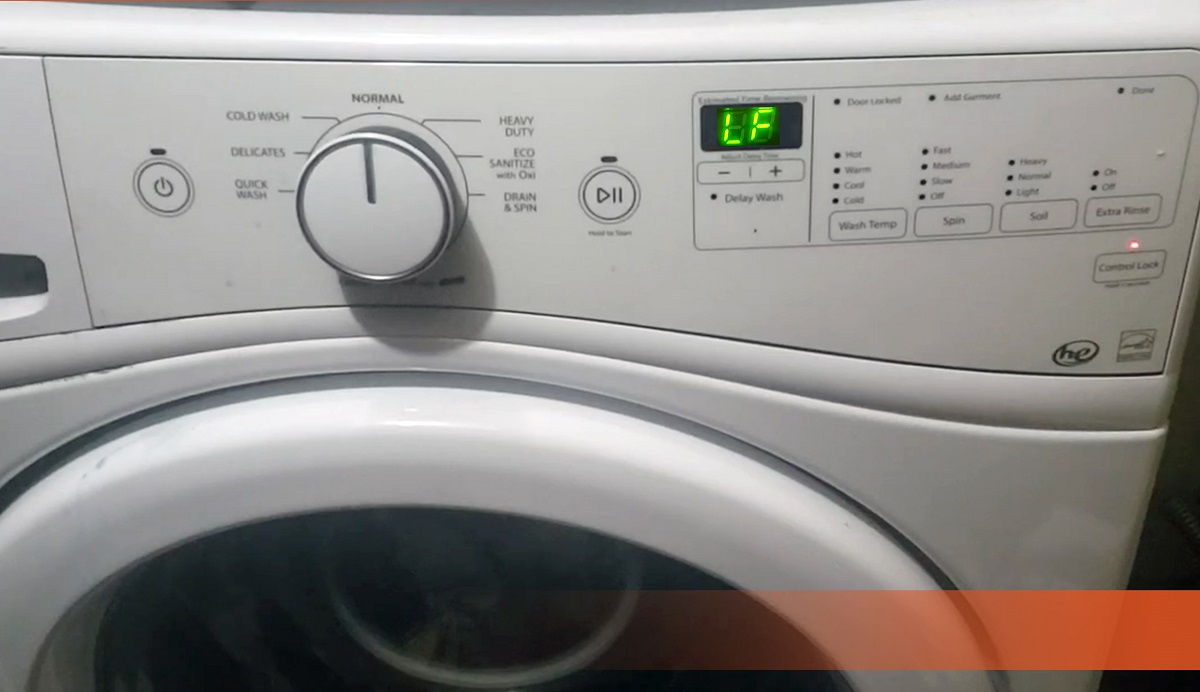

Articles
What Does Delicate Mean On A Washer
Modified: December 6, 2023
Discover what the term "delicate" signifies on a washer and explore insightful articles that shed light on this washing machine feature.
(Many of the links in this article redirect to a specific reviewed product. Your purchase of these products through affiliate links helps to generate commission for Storables.com, at no extra cost. Learn more)
Introduction
The delicate cycle on a washing machine is a setting that is specifically designed to handle more fragile fabrics and garments. It uses a gentler wash cycle, lower water temperatures, and slower spin speed to minimize the risk of damage to delicate items.
When it comes to doing laundry, not all clothes are created equal. Some fabrics, such as silk, lace, or cashmere, require extra care to maintain their quality and longevity. This is where the delicate cycle becomes indispensable. Understanding how to use this setting properly can help you protect your delicate garments and keep them looking their best for years to come.
In this article, we will explore the delicate cycle in-depth, discuss the benefits of using it, provide guidelines for selecting appropriate garments, offer washing instructions, share tips for taking care of delicate fabrics, and highlight common mistakes to avoid. By the end, you’ll be equipped with the knowledge you need to confidently tackle your delicate laundry with ease.
Key Takeaways:
- Embrace the delicate cycle to protect your fragile fabrics. Enjoy gentle cleaning, fabric preservation, and convenience while avoiding common mistakes for long-lasting, beautiful garments.
- Selecting the right garments and following proper washing instructions are crucial for utilizing the delicate cycle effectively. Preserve delicate fabrics and enjoy their beauty for years to come.
Read more: What Does Dl Mean On A Washer
Understanding Delicate Cycle
The delicate cycle is a setting on washing machines specifically designed to handle more delicate fabrics. It offers a gentler wash and spin cycle, reducing the risk of damage to your precious garments. But what exactly happens during a delicate cycle? Let’s dive in and take a closer look.
When you select the delicate cycle, the washing machine adjusts various parameters to ensure a gentle wash. Firstly, it reduces the agitation of the drum, minimizing the movement and friction that can harm delicate fabrics. This gentle movement helps prevent stretching, snagging, or tearing of the material.
In addition, the delicate cycle typically uses lower water temperatures. Hot water can cause certain fabrics to shrink or lose their shape, so the delicate cycle uses cooler water to protect against this. It’s important to note that different fabrics may have specific temperature requirements, so always refer to the garment’s care label for the recommended water temperature.
Another important feature of the delicate cycle is the slower spin speed. This less vigorous spinning minimizes the strain on delicate fabrics, reducing the chances of wrinkling or distortion. The slower spin speed also helps prevent damage to any delicate trims, lace, or embellishments that may be attached to the garment.
Overall, using the delicate cycle helps to maintain the integrity and appearance of delicate fabrics, ensuring that they retain their beauty and longevity.
Benefits of Using Delicate Cycle
The delicate cycle offers several benefits that make it a valuable feature of modern washing machines. Let’s explore some of the advantages of using the delicate cycle for your delicate garments:
- Gentle cleaning: The delicate cycle provides a gentle yet effective cleaning process for delicate fabrics. It reduces the risk of damage to garments, ensuring that they come out clean without compromising their quality.
- Prevents fabric damage: Delicate fabrics, such as silk, lace, or chiffon, can easily get damaged when washed with regular cycles. The delicate cycle minimizes the risk of stretching, snagging, or tearing, allowing these fabrics to retain their shape and appearance for longer.
- Preserves fabric integrity: By using lower water temperatures and slower spin speeds, the delicate cycle helps preserve the integrity of delicate fabrics. It prevents shrinkage, color fading, and distortion, ensuring that your garments stay in great condition even after multiple washes.
- Protects embellishments and trims: Delicate garments often come with delicate trims, lace, or embellishments that require extra care. The delicate cycle’s gentle movement and slower spin speed help protect these elements from damage, keeping your garments looking beautiful and intact.
- Convenience and time-saving: With the delicate cycle, you can conveniently wash your delicate items without worrying about hand washing or taking them to a professional cleaner. This saves you time and effort while still ensuring that your delicate garments receive the care they need.
- Versatility: The delicate cycle is not only suitable for delicate fabrics but can also be used for other sensitive items, including baby clothes, lingerie, or items with special care requirements. It offers a versatile cleaning option for a range of delicate items in your laundry.
By utilizing the delicate cycle, you can enjoy these benefits and have peace of mind knowing that your delicate garments are being treated with the care and attention they deserve during the laundering process.
Proper Garments for Delicate Cycle
The delicate cycle is specifically designed for more fragile fabrics and garments. Knowing which items are suitable for the delicate cycle will help you make informed decisions when it comes to laundry day. Here are some common types of garments that are typically suitable for the delicate cycle:
- Silk: Silk is a delicate fabric that requires special care. The gentle movement and lower water temperature of the delicate cycle are ideal for maintaining the quality of silk garments.
- Lace: Lace is intricate and delicate, prone to snagging or stretching. The delicate cycle helps protect the delicate threads and structures of lace items during the wash.
- Delicate knits: Delicate knitted garments, like cashmere or merino wool, can lose their shape or become misshapen when washed with regular cycles. The delicate cycle ensures a gentle handling that preserves the softness and structure of these items.
- Sheer fabrics: Sheer fabrics, such as chiffon or organza, are prone to tearing or snags. The delicate cycle minimizes the risk of damage, allowing these delicate fabrics to be safely cleaned.
- Intimate apparel: Delicate undergarments, like bras, panties, and lingerie, should be washed using the delicate cycle to protect the delicate fabrics, elastic, and embellishments.
- Delicate or embroidered fabrics: Any garment with delicate embroidery, beading, or sequins should be washed on the delicate cycle to prevent damage to the decorative elements.
It’s important to note that while the delicate cycle is suitable for these types of garments, it may not be suitable for every item within these categories. Always refer to the care label on each garment for specific instructions on washing and care. Some fabrics within these categories may have special requirements or may recommend hand washing instead.
By selecting the appropriate garments for the delicate cycle, you can ensure that your delicate items receive the care they need and maintain their quality and appearance for years to come.
Delicate on a washer refers to a setting designed for fragile items like lingerie and silk. Use this setting to ensure gentle washing and avoid damage to delicate fabrics. Always check the care label for specific instructions.
Washing Instructions for Delicate Clothes
Proper washing instructions are crucial when it comes to preserving the integrity of delicate clothes. The delicate cycle provides a gentle approach, but there are still some steps you should follow to ensure the best results. Here are some key guidelines to consider:
- Sort your garments: Separate your delicate clothes from regular laundry to avoid potential damage from rougher fabrics or zippers. Keep delicate items with similar care requirements together.
- Pre-treat stains: Treat any stains on your delicate garments before placing them in the washing machine. Use a mild stain remover or a gentle detergent specifically formulated for delicate fabrics.
- Close zippers and fasten buttons: Before placing delicate items in the washing machine, ensure that zippers are closed, buttons are fastened, and any strings or ties are secured. This helps prevent tangling and potential damage.
- Use a gentle detergent: Choose a detergent specifically designed for delicate fabrics. Avoid using harsh chemicals or bleach, as they can damage the fibers and colors of delicate clothes. Follow the detergent manufacturer’s instructions for the recommended amount to use.
- Select the delicate cycle: Set your washing machine to the delicate cycle. This cycle typically uses a slower spin speed and lower water temperature, which is gentler on delicate fabrics.
- Avoid overloading the machine: Ensure you don’t overload the washing machine. Leave enough space for the clothes to move freely and get properly cleaned without excessive friction or pulling.
- Choose a gentle spin: If your washing machine allows you to modify the spin cycle, select a slower or delicate spin option to minimize strain on delicate fabrics.
- Use a mesh laundry bag: For extra protection, place delicate items in a mesh laundry bag. This will help prevent tangling, snagging, or stretching during the wash cycle.
- Avoid fabric softeners: While fabric softeners may leave a lovely scent, they can damage delicate fibers and reduce the absorbency of certain fabrics. It’s best to skip the fabric softener when washing delicate clothes.
- Hang or lay flat to dry: After the delicate cycle is complete, remove the clothes promptly and reshape them if necessary. Hang them or lay them flat to air dry. Avoid using the dryer, as heat can cause shrinkage or damage delicate fabrics.
By following these washing instructions, you can effectively clean your delicate clothes while protecting their quality and ensuring they stay in great condition for years to come.
Read more: What Does De Mean On Washer
Tips for Taking Care of Delicate Fabrics
Delicate fabrics require special attention and care to keep them looking their best. By following these tips, you can prolong the life of your delicate garments and maintain their beauty:
- Read the care labels: Always check the care labels on your delicate clothing items. They provide valuable guidance on how to properly wash, dry, and care for the specific fabric.
- Hand wash when necessary: While the delicate cycle is suitable for many delicate fabrics, some may still require hand washing. If the care label recommends hand washing, take the extra time to gently clean the garment by hand.
- Spot clean when possible: For minor stains and spills on delicate fabrics, spot cleaning can be effective. Use a mild detergent or stain remover and gently dab the affected area with a clean cloth. Avoid rubbing or scrubbing vigorously to prevent damage.
- Store properly: When storing delicate garments, choose a cool, dry place away from direct sunlight. Avoid hanging delicate items with thin straps or delicate fabrics as they may stretch or lose their shape over time. Instead, fold them neatly and store them in a drawer or breathable storage containers.
- Avoid excessive scrubbing: When hand washing delicate items, avoid excessive scrubbing as it can weaken the fabric. Instead, gently swish the garment in the soapy water and rinse thoroughly.
- Use a pressing cloth: To iron delicate fabrics, place a pressing cloth between the fabric and the iron. This prevents direct heat contact and minimizes the risk of burning or damaging the delicate material.
- Test for colorfastness: Before washing or spot cleaning a delicate item, test for colorfastness in a small, inconspicuous area. Apply a small amount of water and detergent to the area and dab with a clean cloth. If the colors bleed or fade, it’s best to seek professional cleaning or use a different cleaning method.
- Handle with care: When handling delicate fabrics, especially those with delicate trims or embellishments, be gentle. Avoid pulling or stretching the fabric and handle it with clean, dry hands to minimize the transfer of oils and dirt.
- Store away from pets and sharp objects: Keep delicate fabrics away from pets that may scratch or snag them. Additionally, store them away from sharp objects that can cause tears or snags.
- Consider professional cleaning: For delicate items that require extra care or have intricate detailing, professional cleaning may be the best option. Professional cleaners are experienced in handling delicate fabrics and can help maintain their quality.
By following these tips, you can ensure that your delicate fabrics remain in excellent condition and continue to bring you joy for years to come.
Common Mistakes to Avoid on the Delicate Cycle
While the delicate cycle is designed to protect delicate fabrics, there are still some common mistakes that can lead to damage or reduced effectiveness. Here are some mistakes to avoid when using the delicate cycle:
- Overloading the machine: It can be tempting to maximize the load size, but overloading the washing machine can prevent proper cleaning and may cause excessive friction and damage to delicate fabrics.
- Not using a mesh laundry bag: For smaller or more delicate items, like lingerie or lace garments, it’s essential to use a mesh laundry bag. This helps prevent tangling, snagging, and stretching during the wash cycle.
- Using harsh detergents or bleach: Harsh detergents and bleach can be too aggressive for delicate fabrics, causing damage or discoloration. Opt for gentle detergents specifically formulated for delicate fabrics.
- Skipping pre-treatment: Stains should be pre-treated before washing, even on the delicate cycle. Ignoring pre-treatment can lead to stains becoming set in and harder to remove during the wash.
- Using hot water: The delicate cycle uses lower water temperatures to protect delicate fabrics. Using hot water can cause shrinkage, color fading, and damage to delicate fibers, so always follow the recommended water temperature for your items.
- Not checking the spin speed: Some washing machines allow you to adjust the spin speed for the delicate cycle. Be sure to select a slower spin speed to minimize strain on delicate fabrics and reduce the risk of wrinkling or distortion.
- Forgetting to air dry: The delicate cycle sets the stage for proper washing, but using a dryer can still be damaging to delicate fabrics. Always air dry your delicate items to prevent shrinkage, loss of shape, or damage from excessive heat.
- Not reading care labels: Each delicate item may have specific care instructions. Always check the care labels before washing to ensure you are following the manufacturer’s recommended guidelines.
- Aggressive handling: Even with a gentle cycle, rough handling of delicate garments can lead to stretching, tearing, or distortion. Handle delicate items with care and avoid pulling or yanking them when placing them in or removing them from the washing machine.
- Ignoring the suitability of the delicate cycle: While the delicate cycle is ideal for many delicate fabrics, not all delicate items can be washed using this setting. Some fabrics or garments may require alternate care methods, such as hand washing or dry cleaning, so be sure to read the care label instructions carefully.
By avoiding these common mistakes and following proper care instructions, you can ensure that your delicate items are treated with the care they deserve and maintain their quality and appearance over time.
Conclusion
The delicate cycle is a valuable feature on washing machines that provides a gentle and effective way to clean delicate fabrics. By understanding how to use this setting properly and following the guidelines outlined in this article, you can effectively care for your delicate garments while preserving their quality and lifespan.
Using the delicate cycle offers several benefits, including gentle cleaning, preventing fabric damage, preserving fabric integrity, and protecting delicate trims and embellishments. It also provides convenience and versatility, allowing you to safely clean a variety of delicate items at home without the need for professional cleaning or hand washing.
Remember to choose the appropriate garments for the delicate cycle and always refer to the care labels for specific instructions. Sort your garments, pre-treat stains, and use a gentle detergent. Avoid overloading the machine, choose a gentle spin, and consider using a mesh laundry bag for added protection. After the cycle, air drying your delicate clothes is essential for preventing shrinkage or damage from heat.
Additionally, taking care of delicate fabrics extends beyond the washing machine. Use proper storage techniques, handle garments with care, and consider professional cleaning for intricate or delicate items when necessary.
By following these tips and avoiding common mistakes, you can ensure that your delicate fabrics remain in excellent condition, allowing you to enjoy them for years to come.
So go ahead, embrace the delicate cycle and give your delicate clothes the care they deserve!
Frequently Asked Questions about What Does Delicate Mean On A Washer
Was this page helpful?
At Storables.com, we guarantee accurate and reliable information. Our content, validated by Expert Board Contributors, is crafted following stringent Editorial Policies. We're committed to providing you with well-researched, expert-backed insights for all your informational needs.















0 thoughts on “What Does Delicate Mean On A Washer”